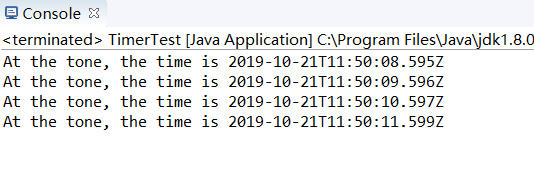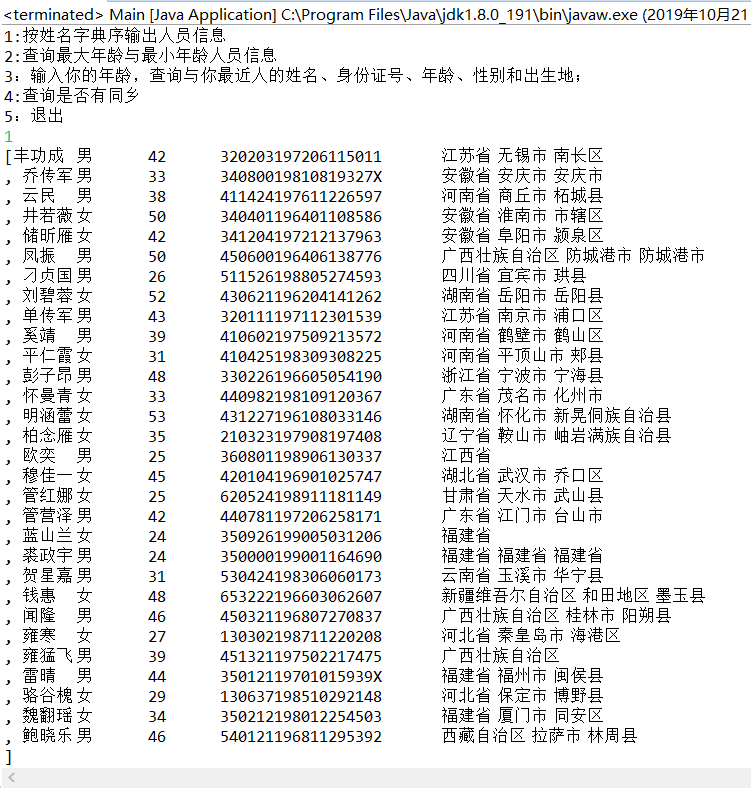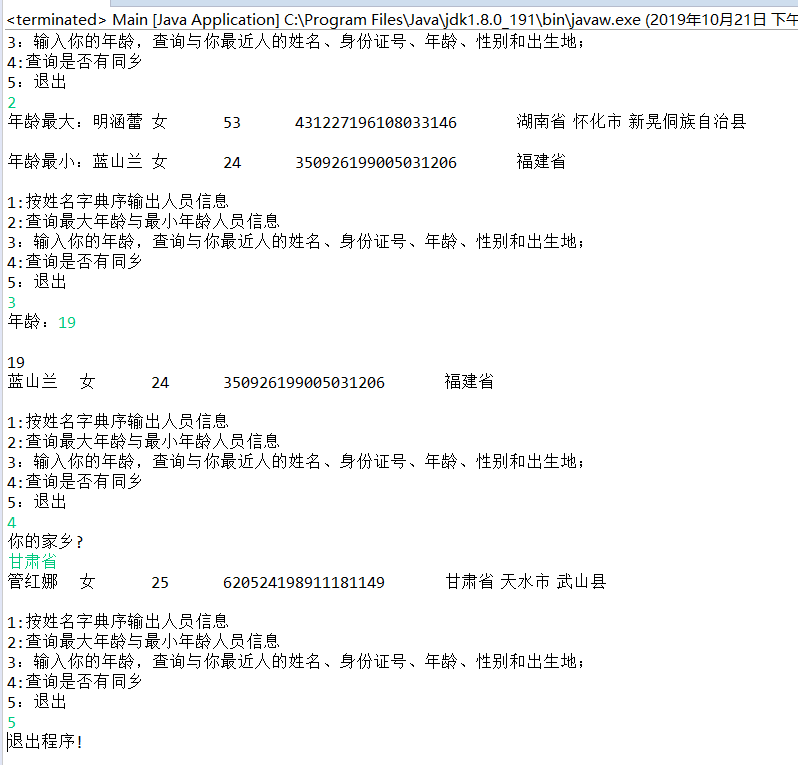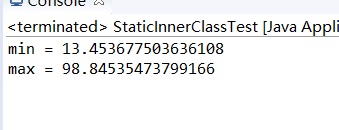201871010107-公海瑜《面向对象程序设计(java)》第八周学习总结
201871010107-公海瑜《面向对象程序设计(java)》第八周学习总结
| 项目 | 内容 |
| 这个作业属于哪个课程 | https://www.cnblogs.com/nwnu-daizh/ |
| 这个作业的要求在哪里 | https://www.cnblogs.com/nwnu-daizh/p/11703678.html |
| 作业学习目标 |
(1) 掌握接口定义方法; (2) 掌握实现接口类的定义要求; (3) 掌握实现了接口类的使用要求; (4) 掌握程序回调设计模式; (5) 掌握Comparator接口用法; (6) 掌握对象浅层拷贝与深层拷贝方法; (7) 掌握Lambda表达式语法; (8) 了解内部类的用途及语法要求。 |
第一部分:总结第六章理论知识
1.什么是接口:在Java程序语言设计中,接口不是类,而是对类的一组需求描述,由常量和一组抽象方法组成。Java为了克服单继承的缺点,Java使用了接口,一个类可以实现一个或多个接口。
接口中不包括变量和有具体方法的实现。只要类实现了接口,则该类要遵从接口描述的统一格式进行定义,并且可以在任何需要该接口的地方使用这个接口。
2.接口的声明:声明方式:public interface 接口名{……}
接口体中包含常量定义和方法定义,接口中只进行方法的声明,不提供方法的实现。
3.类似建立类的继承关系,接口也可以扩展。接口的扩展技术使得从具有较高通用型的接口存在多条链延伸到具有较高专用性的接口。
说明:(1)通常接口的名字以able或ible结尾,
(2)可以使用extends来继承接口的常量和抽象方法,扩展形成新的接口。
(3)接口中的所有常量都必须是public static final,方法必须是public abstract,这是系统默认的,不管你在定义接口时,写不写修饰符都是一样的。
4.接口的实现:(1)在类声明时用implements 关键字声明使用一个或多个接口。
(2)一个类使用了某个接口,那么这个类必须实现该接口的所有方法,即为这些方法提供方法体。
(3)一个类可以实现多个接口,接口之间用逗号隔开。
说明:若实现接口的类不是抽象类,则必须实现所有接口的所有方法,即为所有的抽象方法定义方法体。
一个类在实现某接口抽象方法时,必须使用完全相同的方法名,参数列表和返回值类型。
接口抽象方法的访问修饰符已定为public,所以在类实现时 必须显示的使用public修饰符。否则会被警告缩小了接口中定义的方法的访问控制范围。
5.接口的使用:接口不能构造接口对象,但可以声明接口变量以指向一个实现了改接口的类对象。
可以用instanceof检查对象是否实现了某个接口。
6.接口与抽象类的区别:
(1)接口不能实现任何方法,而抽象类可以。
(2)类可以实现许多接口,但只有一个父类。
(3)接口不是类分级结构的一部分,无任何联系的类可以实现相同的接口。
7.回调:一种程序设计模式,在这种模式中,可指出某个特定的时间发生时程序应该采取的动作。
在Java.swing包中有一个timer类,可以使用他在给定的时间间隔触发一个事件。
8.Comparator接口:在Java.util*包中。处理字符串按长度进行排序的操作。
9.克隆:(1)object类的克隆方法:当拷贝一个对象变量时,原始变量与拷贝变量引用同一个对象。这样,改变一个变量所引用的对象会对另一个变量产生影响。
(2)如果要创建一个新的copy,它的最初状态与original一样,但以后可以各自改变状态,就需要使用object类的clone方法。
10.浅层拷贝:被拷贝对象的所有常量成员和基本类型属性都有与原来对象相同的拷贝值,而若成员域是一个对象,则被拷贝对象该对象域的对象引用仍指向原来的对象。
深层拷贝:被拷贝对象的所有成员域都含有与原来对象相同的值,且对象域将指向被复制过的新的对象,而不是原有对象被引用的对象。
11.对象克隆:在类中实现Cloneable接口。
为了获取对象的一份拷贝,使用object类的clone方法。
在类中覆盖超类的clone方法,声明为public。
在类的clone方法中,调用super.clone方法。
12.lambda表达式:主要用途是提供一个函数化的语法来简化编码。
13.lambda表达式
1) 传代码而非传值。
2) lambda的语法规则:(参数)->以及一个表达式
3)如果计算无法在一个表达式中完成,那么就使用{}。
4)即使lambda没有参数,仍然要提供空括号,就算无参方法一样。
5)如果可以推导出一个lambda表达式的参数类型,则可以忽略其类型。
6)如果方法只要一个参数,而且这个 参数的类型可以推导得出,那么甚至可以省略小括号。
7)无需指定lambda表达式的返回类型。lambda表达式返回类型总可以由上下文推导出。
8)如果一个lambda表达式只在某些分支返回一个值,而在另一些分支不返回,这是不合法的。
9)只有一个抽象方法的接口,称为函数式接口。
10)lambda表达式中捕获的变量必须是最终变量,这个变量初始化之后就不能再为他赋新值,不能做更改。
11)在lambda表达式中,声明一个与局部变量同名的参数或局部变量是不可合法的。
12)在一个lambda表达式中使用this关键字,是指创建这个lambda表达式的方法的this参数。
14.内部类
作用:内部类方法可以访问外围类的数据,包括私有的数据.内部类可以对同一个包种的其他类隐藏起来. 使用anonymous内部类定义回调函数类。
第二部分:实验部分
实验1:导入第6章示例程序,测试程序并进行代码注释。
测试程序1:
l 编辑、编译、调试运行阅读教材214页-215页程序6-1、6-2,理解程序并分析程序运行结果;
l 在程序中相关代码处添加新知识的注释。
l 掌握接口的实现用法;
掌握内置接口Compareable的用法。
6-1, 6-2 代码如下:
package interfaces; import java.util.*; /**
* This program demonstrates the use of the Comparable interface.
* @version 1.30 2004-02-27
* @author Cay Horstmann
*/
public class EmployeeSortTest
{
public static void main(String[] args)
{
Employee[] staff = new Employee[]; //用三个staff对象填充数组;
staff[] = new Employee("Harry Hacker", );
staff[] = new Employee("Carl Cracker", );
staff[] = new Employee("Tony Tester", ); Arrays.sort(staff); // print out information about all Employee objects
for (Employee e : staff) //按字母排序方法;
System.out.println("name=" + e.getName() + ",salary=" + e.getSalary());
}
}
package interfaces; public class Employee implements Comparable<Employee>
{
//声明属性;
private String name;
private double salary; public Employee(String name, double salary)
{
this.name = name;
this.salary = salary;
} public String getName()
{
return name;
} public double getSalary()
{
return salary;
}
//计算工资方法;
public void raiseSalary(double byPercent)
{
double raise = salary * byPercent / ;
salary += raise;
} /**
* Compares employees by salary
* @param other another Employee object
* @return a negative value if this employee has a lower salary than
* otherObject, 0 if the salaries are the same, a positive value otherwise
*/
public int compareTo(Employee other)
{
return Double.compare(salary, other.salary);
}
}
运行结果如图:

测试程序2:
| 编辑、编译、调试以下程序,结合程序运行结果理解程序;
interface A
{
double g=9.8;
void show( );
}
class C implements A
{
public void show( )
{System.out.println("g="+g);}
} class InterfaceTest
{
public static void main(String[ ] args)
{
A a=new C( );
a.show( );
System.out.println("g="+C.g); //C实现了接口A,所以可以用C调用A中的变量
} }
运行结果如图:

测试程序3:
l 在elipse IDE中调试运行教材223页6-3,结合程序运行结果理解程序;
l 26行、36行代码参阅224页,详细内容涉及教材12章。
l 在程序中相关代码处添加新知识的注释。
l 掌握回调程序设计模式;
程序代码如下:
/**
@version 1.01 2015-05-12
@author Cay Horstmann
*/ import java.awt.*;
import java.awt.event.*;
import java.util.*;
import javax.swing.*;
import javax.swing.Timer;
// to resolve conflict with java.util.Timer public class TimerTest
{
public static void main(String[] args)
{
ActionListener listener = new TimePrinter(); // 构造一个timer对象存放在变量里,叫做listener
// 每次间隔10秒
Timer t = new Timer(, listener);
t.start(); JOptionPane.showMessageDialog(null, "Quit program?");
System.exit();
}
} class TimePrinter implements ActionListener
{
public void actionPerformed(ActionEvent event)
{
System.out.println("At the tone, the time is " + new Date());
Toolkit.getDefaultToolkit().beep();
//每隔10秒响一次
}
}
运行结果如图:

测试程序4:
l 调试运行教材229页-231页程序6-4、6-5,结合程序运行结果理解程序;
l 在程序中相关代码处添加新知识的注释。
l 掌握对象克隆实现技术;
l 掌握浅拷贝和深拷贝的差别。
6-4,6-5 代码如下:
package clone; /**
* This program demonstrates cloning.
* @version 1.10 2002-07-01
* @author Cay Horstmann
*/
public class CloneTest
{
public static void main(String[] args)
{
try
//放入try中,配合后面的语句捕获异常
{
Employee original = new Employee("John Q. Public", );
original.setHireDay(, , );
Employee copy = original.clone();
copy.raiseSalary();
copy.setHireDay(, , );
System.out.println("original=" + original);
System.out.println("copy=" + copy);
}
catch (CloneNotSupportedException e)
//捕获异常
{
e.printStackTrace();
}
}
}
package clone; import java.util.Date;
import java.util.GregorianCalendar; public class Employee implements Cloneable
{
private String name;
private double salary;
private Date hireDay; public Employee(String name, double salary)
{
this.name = name;
this.salary = salary;
hireDay = new Date();
} public Employee clone() throws CloneNotSupportedException
{
// call Object.clone()
Employee cloned = (Employee) super.clone(); // clone mutable fields
cloned.hireDay = (Date) hireDay.clone(); return cloned;
} /**
* Set the hire day to a given date.
* @param year the year of the hire day
* @param month the month of the hire day
* @param day the day of the hire day
*/
public void setHireDay(int year, int month, int day)
{
Date newHireDay = new GregorianCalendar(year, month - , day).getTime(); // Example of instance field mutation
hireDay.setTime(newHireDay.getTime());
} public void raiseSalary(double byPercent)
{
double raise = salary * byPercent / ;
salary += raise;
} public String toString()
{
return "Employee[name=" + name + ",salary=" + salary + ",hireDay=" + hireDay + "]";
}
}
运行结果如图:

实验2: 导入第6章示例程序6-6,学习Lambda表达式用法。
l 调试运行教材233页-234页程序6-6,结合程序运行结果理解程序;
l 在程序中相关代码处添加新知识的注释。
l 将27-29行代码与教材223页程序对比,将27-29行代码与此程序对比,体会Lambda表达式的优点。
程序代码如下:
package lambda; import java.util.*; import javax.swing.*;
import javax.swing.Timer; /**
* This program demonstrates the use of lambda expressions.
* @version 1.0 2015-05-12
* @author Cay Horstmann
*/
public class LambdaTest
{
public static void main(String[] args)
{
String[] planets = new String[] { "Mercury", "Venus", "Earth", "Mars",
"Jupiter", "Saturn", "Uranus", "Neptune" };
System.out.println(Arrays.toString(planets));
System.out.println("Sorted in dictionary order:");
Arrays.sort(planets); //调用Arrays类的sort方法
System.out.println(Arrays.toString(planets));
System.out.println("Sorted by length:");
Arrays.sort(planets, (first, second) -> first.length() - second.length());
System.out.println(Arrays.toString(planets)); Timer t = new Timer(, event ->
System.out.println("The time is " + new Date()));
t.start(); // keep program running until user selects "Ok"
JOptionPane.showMessageDialog(null, "Quit program?");
System.exit();
}
}
运行结果如图:

实验3: 编程练习
l 编制一个程序,将身份证号.txt 中的信息读入到内存中;
l 按姓名字典序输出人员信息;
l 查询最大年龄的人员信息;
l 查询最小年龄人员信息;
l 输入你的年龄,查询身份证号.txt中年龄与你最近人的姓名、身份证号、年龄、性别和出生地;
l 查询人员中是否有你的同乡。
程序代码如下:
import java.io.BufferedReader;
import java.io.File;
import java.io.FileInputStream;
import java.io.FileNotFoundException;
import java.io.IOException;
import java.io.InputStreamReader;
import java.util.ArrayList;
import java.util.Arrays;
import java.util.Collections;
import java.util.Scanner; public class Main{
private static ArrayList<Student> studentlist;
public static void main(String[] args) {
studentlist = new ArrayList<>();
Scanner scanner = new Scanner(System.in);
File file = new File("C:\\Users\\ASUS\\Desktop\\新建文件夹\\身份证号.txt");
try {
FileInputStream fis = new FileInputStream(file);
BufferedReader in = new BufferedReader(new InputStreamReader(fis));
String temp = null;
while ((temp = in.readLine()) != null) { Scanner linescanner = new Scanner(temp); linescanner.useDelimiter(" ");
String name = linescanner.next();
String number = linescanner.next();
String sex = linescanner.next();
String age = linescanner.next();
String province =linescanner.nextLine();
Student student = new Student();
student.setName(name);
student.setnumber(number);
student.setsex(sex);
int a = Integer.parseInt(age);
student.setage(a);
student.setprovince(province);
studentlist.add(student); }
} catch (FileNotFoundException e) {
System.out.println("学生信息文件找不到");
e.printStackTrace();
} catch (IOException e) {
System.out.println("学生信息文件读取错误");
e.printStackTrace();
}
boolean isTrue = true;
while (isTrue) {
System.out.println("选择你的操作,输入正确格式的选项");
System.out.println("A.字典排序");
System.out.println("B.输出年龄最大和年龄最小的人");
System.out.println("C.寻找老乡");
System.out.println("D.寻找年龄相近的人");
System.out.println("F.退出");
String m = scanner.next();
switch (m) {
case "A":
Collections.sort(studentlist);
System.out.println(studentlist.toString());
break;
case "B":
int max=,min=;
int j,k1 = ,k2=;
for(int i=;i<studentlist.size();i++)
{
j=studentlist.get(i).getage();
if(j>max)
{
max=j;
k1=i;
}
if(j<min)
{
min=j;
k2=i;
} }
System.out.println("年龄最大:"+studentlist.get(k1));
System.out.println("年龄最小:"+studentlist.get(k2));
break;
case "C":
System.out.println("老家?");
String find = scanner.next();
String place=find.substring(,);
for (int i = ; i <studentlist.size(); i++)
{
if(studentlist.get(i).getprovince().substring(,).equals(place))
System.out.println("老乡"+studentlist.get(i));
}
break; case "D":
System.out.println("年龄:");
int yourage = scanner.nextInt();
int near=agenear(yourage);
int value=yourage-studentlist.get(near).getage();
System.out.println(""+studentlist.get(near));
break;
case "F":
isTrue = false;
System.out.println("退出程序!");
break;
default:
System.out.println("输入有误"); }
}
}
public static int agenear(int age) {
int j=,min=,value=,k=;
for (int i = ; i < studentlist.size(); i++)
{
value=studentlist.get(i).getage()-age;
if(value<) value=-value;
if (value<min)
{
min=value;
k=i;
}
}
return k;
} }
public class Student implements Comparable<Student> {
private String name;
private String number ;
private String sex ;
private int age;
private String province;
public String getName() {
return name;
}
public void setName(String name) {
this.name = name;
}
public String getnumber() {
return number;
}
public void setnumber(String number) {
this.number = number;
}
public String getsex() {
return sex ;
}
public void setsex(String sex ) {
this.sex =sex ;
}
public int getage() {
return age;
}
public void setage(int age) {
// int a = Integer.parseInt(age);
this.age= age;
}
public String getprovince() {
return province;
}
public void setprovince(String province) {
this.province=province ;
}
public int compareTo(Student o) {
return this.name.compareTo(o.getName());
}
public String toString() {
return name+"\t"+sex+"\t"+age+"\t"+number+"\t"+province+"\n";
}
}
运行结果如图:


实验4:内部类语法验证实验
实验程序1:
l 编辑、调试运行教材246页-247页程序6-7,结合程序运行结果理解程序;
l 了解内部类的基本用法。
代码如下:
import java.awt.*;
import java.awt.event.*;
import java.util.*;
import javax.swing.*;
import javax.swing.Timer; /**
* This program demonstrates the use of inner classes.
* @version 1.11 2015-05-12
* @author Cay Horstmann
*/
public class InnerClassTest
{
public static void main(String[] args)
{
TalkingClock clock = new TalkingClock(, true);
clock.start(); // keep program running until user selects "Ok"
JOptionPane.showMessageDialog(null, "Quit program?");
System.exit();
}
} /**
* A clock that prints the time in regular intervals.
*/
class TalkingClock
{
private int interval;
private boolean beep; /**
* Constructs a talking clock
* @param interval the interval between messages (in milliseconds)
* @param beep true if the clock should beep
*/
public TalkingClock(int interval, boolean beep)
{
this.interval = interval;
this.beep = beep;
} /**
* Starts the clock.
*/
public void start()
{
ActionListener listener = new TimePrinter();
Timer t = new Timer(interval, listener);
t.start();
} public class TimePrinter implements ActionListener
{
public void actionPerformed(ActionEvent event)
{
System.out.println("At the tone, the time is " + new Date());
if (beep) Toolkit.getDefaultToolkit().beep();
}
}
}
运行结果如图:

实验程序2:
l 编辑、调试运行教材254页程序6-8,结合程序运行结果理解程序;
掌握匿名内部类的用法。
代码如下:
import java.awt.*;
import java.awt.event.*;
import java.util.*;
import javax.swing.*;
import javax.swing.Timer; /**
* This program demonstrates anonymous inner classes.
* @version 1.11 2015-05-12
* @author Cay Horstmann
*/
public class AnonymousInnerClassTest
{
public static void main(String[] args)
{
TalkingClock clock = new TalkingClock();
clock.start(, true); // keep program running until user selects "Ok"
JOptionPane.showMessageDialog(null, "Quit program?");
System.exit();
}
} /**
* A clock that prints the time in regular intervals.
*/
class TalkingClock
{
/**
* Starts the clock.
* @param interval the interval between messages (in milliseconds)
* @param beep true if the clock should beep
*/
public void start(int interval, boolean beep)
{
ActionListener listener = new ActionListener()
{
public void actionPerformed(ActionEvent event)
{
System.out.println("At the tone, the time is " + new Date());
if (beep) Toolkit.getDefaultToolkit().beep();
}
};
Timer t = new Timer(interval, listener);
t.start();
}
}
运行结果如图:

实验程序3:
l 在elipse IDE中调试运行教材257页-258页程序6-9,结合程序运行结果理解程序;
l 了解静态内部类的用法。
代码如下:
/**
* This program demonstrates the use of static inner classes.
* @version 1.02 2015-05-12
* @author Cay Horstmann
*/
public class StaticInnerClassTest
{
public static void main(String[] args)
{
double[] d = new double[];
for (int i = ; i < d.length; i++)
d[i] = * Math.random();
ArrayAlg.Pair p = ArrayAlg.minmax(d);
System.out.println("min = " + p.getFirst());
System.out.println("max = " + p.getSecond());
}
} class ArrayAlg
{
/**
* A pair of floating-point numbers
*/
public static class Pair
{
private double first;
private double second; /**
* Constructs a pair from two floating-point numbers
* @param f the first number
* @param s the second number
*/
public Pair(double f, double s)
{
first = f;
second = s;
} /**
* Returns the first number of the pair
* @return the first number
*/
public double getFirst()
{
return first;
} /**
* Returns the second number of the pair
* @return the second number
*/
public double getSecond()
{
return second;
}
} /**
* Computes both the minimum and the maximum of an array
* @param values an array of floating-point numbers
* @return a pair whose first element is the minimum and whose second element
* is the maximum
*/
public static Pair minmax(double[] values)
{
double min = Double.POSITIVE_INFINITY;
double max = Double.NEGATIVE_INFINITY;
for (double v : values)
{
if (min > v) min = v;
if (max < v) max = v;
}
return new Pair(min, max);
}
}
运行结果如图:

三、实验总结
通过这一周的学习以及周末完成的实验作业,我基本掌握了接口定义方法以及以及实现接口类定义,还学会了Comparator接口用法和Lambda表达式语法,了解了内部类的用途及语法要求。但在这些知识上仍然还有很多不太理解的地方,还需要在之后的学习中慢慢融会贯通。比如只会用接口编写一些简单的程序。这周的学习也让我更加感觉到了学习java的难度,在之后的学习中我会更加认真努力的学习。
201871010107-公海瑜《面向对象程序设计(java)》第八周学习总结的更多相关文章
- 201771010134杨其菊《面向对象程序设计java》第九周学习总结
第九周学习总结 第一部分:理论知识 异常.断言和调试.日志 1.捕获 ...
- 201871010132-张潇潇《面向对象程序设计(java)》第一周学习总结
面向对象程序设计(Java) 博文正文开头 项目 内容 这个作业属于哪个课程 https://www.cnblogs.com/nwnu-daizh/ 这个作业的要求在哪里 https://www.cn ...
- 扎西平措 201571030332《面向对象程序设计 Java 》第一周学习总结
<面向对象程序设计(java)>第一周学习总结 正文开头: 项目 内容 这个作业属于哪个课程 https://www.cnblogs.com/nwnu-daizh/ 这个作业的要求在哪里 ...
- 杨其菊201771010134《面向对象程序设计Java》第二周学习总结
第三章 Java基本程序设计结构 第一部分:(理论知识部分) 本章主要学习:基本内容:数据类型:变量:运算符:类型转换,字符串,输入输出,控制流程,大数值以及数组. 1.基本概念: 1)标识符:由字母 ...
- 201871010124 王生涛《面向对象程序设计JAVA》第一周学习总结
项目 内容 这个作业属于哪个课程 https://www.cnblogs.com/nwnu-daizh/ 这个作业的要求在哪里 https://edu.cnblogs.com/campus/xbsf/ ...
- 201871010115——马北《面向对象程序设计JAVA》第二周学习总结
项目 内容 这个作业属于哪个课程 https://www.cnblogs.com/nwnu-daizh/ 这个作业的要求在哪里 https://www.cnblogs.com/nwnu-daizh/p ...
- 201777010217-金云馨《面向对象程序设计(Java)》第二周学习总结
项目 内容 这个作业属于哪个课程 https://www.cnblogs.com/nwnu-daizh/ 这个作业的要求在哪里 https://www.cnblogs.com/nwnu-daizh/p ...
- 201871010132——张潇潇《面向对象程序设计JAVA》第二周学习总结
项目 内容 这个作业属于哪个课程 https://www.cnblogs.com/nwnu-daizh/ 这个作业的要求在哪里 https://www.cnblogs.com/nwnu-daizh/p ...
- 201771010123汪慧和《面向对象程序设计Java》第二周学习总结
一.理论知识部分 1.标识符由字母.下划线.美元符号和数字组成, 且第一个符号不能为数字.标识符可用作: 类名.变量名.方法名.数组名.文件名等.第二部分:理论知识学习部分 2.关键字就是Java语言 ...
- 20155321 2016-2017-2 《Java程序设计》第八周学习总结
20155321 2016-2017-2 <Java程序设计>第八周学习总结 教材学习内容总结 创建Logger对象 static Logger getLogger(String name ...
随机推荐
- requests的请求机制
库结构: 工作机制: api.py get.post.put.delete等请求方式都在api文件中,另外,api文件中还有个request方法,使用任何一种请求方式都是调用request方法,只是传 ...
- 【转】认识JWT
1. JSON Web Token是什么 JSON Web Token (JWT)是一个开放标准(RFC 7519),它定义了一种紧凑的.自包含的方式,用于作为JSON对象在各方之间安全地传输信息.该 ...
- [C3] Andrew Ng - Neural Networks and Deep Learning
About this Course If you want to break into cutting-edge AI, this course will help you do so. Deep l ...
- lua 3 循环
while() do ... end i=10 while(i>0) do print(i) i=i-1 end repeat ... until() i=10 repeat print(i) ...
- luoguP2852 [USACO06DEC]Milk Patterns
题意 显然如果有一个子串出现过\(k\)次,那么它必定是一个至少长为k的后缀序的\(LCP\),求出所有相邻的长为\(k-1\)的\(height\)数组的最小值,在其中取最大值即可 code: #i ...
- python 利用cip.cc查询IP归属地
def ipinfocip(ip): # 获得 输入框中的信息 url = "http://www.cip.cc/%s" % ip # 模拟浏览器请求网络 headers={'Us ...
- OpenGL ES 入门
写在前面 记录一下 OpenGL ES Android 开发的入门教程.逻辑性可能不那么强,想到哪写到哪.也可能自己的一些理解有误. 参考资料: LearnOpenGL CN Android官方文档 ...
- python接口自动化3-发送post及其他请求
前言 发过get请求相信学习post请求也很快学会,无非就是多了传参时的类型与参数格式.在我常见的post请求中用到最多的是json格式,但也有用其它,下面将介绍常用的参数类型格式. 一.Post请求 ...
- 十、Spring之BeanFactory源码分析(二)
Spring之BeanFactory源码分析(二) 前言 在前面我们简单的分析了BeanFactory的结构,ListableBeanFactory,HierarchicalBeanFactory,A ...
- Spring Security 实战干货:使用 JWT 认证访问接口
(转载)原文链接:https://my.oschina.net/10000000000/blog/3127268 1. 前言 欢迎阅读Spring Security 实战干货系列.之前我讲解了如何编写 ...
